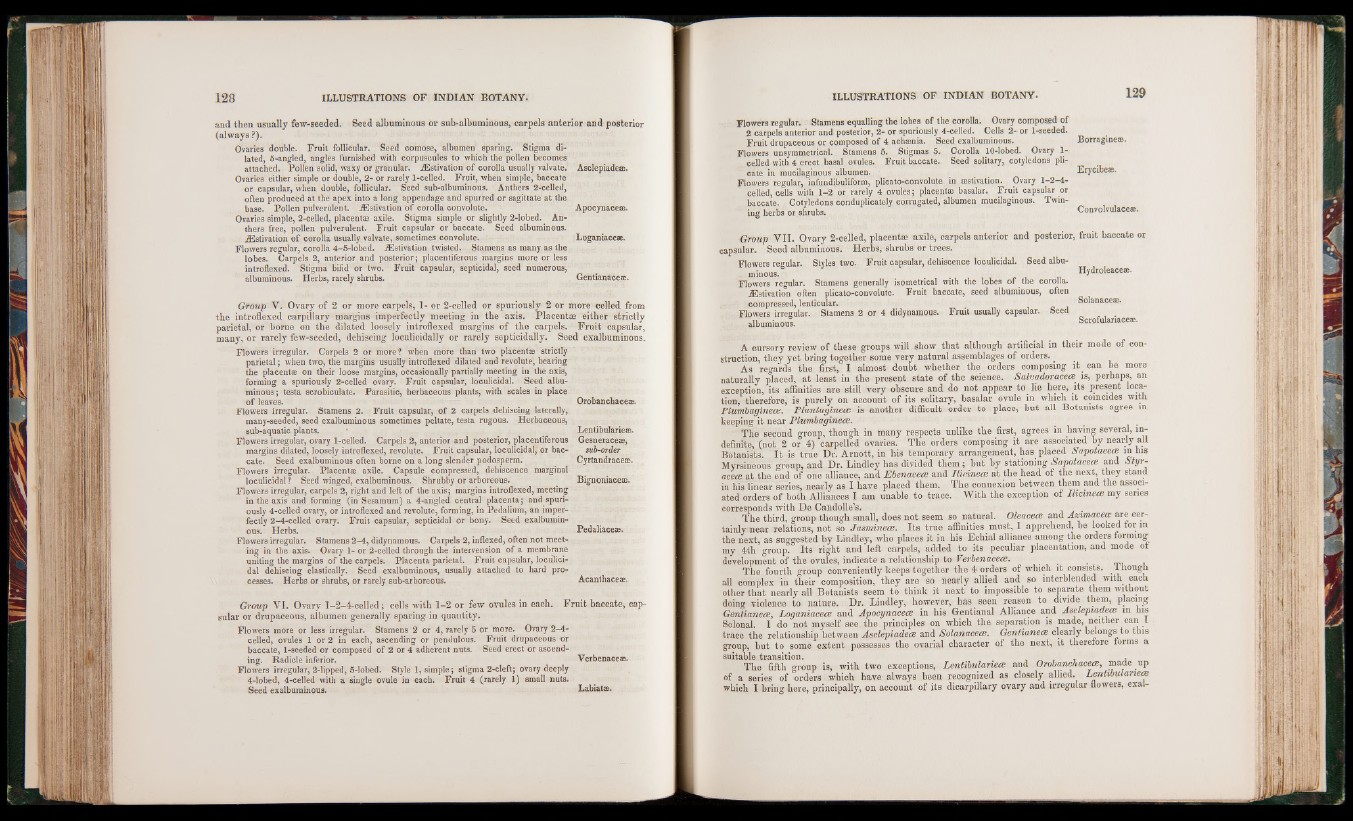
and then usually few-seeded. Seed albuminous or sub-albuminous, carpels anterior and posterior
(always ?).
Ovaries double. Fruit follicular. Seed comose, albumen sparing. Stigma dilated,
5-angled, angles furnished with corpuscules to which the pollen becomes
attached. Pollen solid, waxy or granular. iEstivation of corolla usually valvate.
Ovaries either simple or double, 2- or rarely 1-celled. Fruit, when simple, baccate
or capsular, when double, follicular. Seed sub-albuminous. Anthers 2-celled,
often produced at the apex into a long appendage and spurred or sagittate at the
base. Pollen pulverulent. iEstivation of corolla convolute.
Ovaries simple, 2-celled, placentae axile. Stigma simple or slightly 2-lobed. Anthers
free, pollen pulverulent. Fruit capsular or baccate. Seed albuminous.
Aestivation of corolla usually valvate, sometimes convolute.
Flowers regular, corolla 4-5-lobed. iEstivation twisted. Stamens as many as the
lobes. Carpels 2, anterior and posterior; placentiferous margins more or less
introflexed. Stigma bifid or two. Fruit capsular, septicidal, seed numerous,
albuminous. Herbs, rarely shrubs.
Asclepiadeæ.
Apocynaceæ.
Loganiaceæ.
Gentianaceæ.
Group V. Ovary of 2 or more carpels, 1- or 2-celled or spuriously 2 or more celled from
the introflexed carpillary margins imperfectly meeting in the axis. Placentae either strictly
parietal, or borne on the dilated loosely introflexed margins of the carpels. Fruit capsular,
many, or rarely few-seeded, dehiscing loculicidally or rarely septicidally. Seed exalbuminous.
Flowers irregular. Carpels 2 or more? when more than two placentae strictly
parietal; when two, the margins usually introflexed dilated and revolutej bearing
the placentae on their loose margins, occasionally partially meeting in the axis,
forming a spuriously 2-celled ovary. Fruit capsular, loculicidal. Seed albuminous;
testa scrobiculate. Parasitic, herbaceous plants, with scales in place
of leaves.
Flowers irregular. Stamens 2. Fruit capsular, of 2 carpels dehiscing laterally,
many-seeded, seed exalbuminous sometimes peltate, testa rugous. Herbaceous,
sub-aquatic plants. '
Flowers irregular, ovary l rcelled. Carpels 2, anterior and posterior, placentiferous
margins dilated, loosely introflexed, revolute. Fruit capsular, loculicidal^ or baccate.
Seed exalbuminous often borne on a long slender podosperm.
Flowers irregular. Placentae axile. Capsule compressed, dehiscence marginal
loculicidal? Seed winged, exalbuminous. Shrubby or arboreous.
Flowers irregular, carpels 2, right and left of the axis; margins introflexed, meeting
in the axis and forming (in Sesamum) a 4-angled central placenta; and spuriously
4-celled ovary, or introflexed and revolute, forming, in Pedalium, an imperfectly
2-4-celled ovary. Fruit capsular, septicidal or bony. Seed exalbuminous.
Herbs.
Flowers irregular. Stamens 2-4, didynamous. Carpels 2, inflexed, often not meeting
in the axis. Ovary 1- or 2-celled through the intervension of a membrane
uniting the margins of the carpels. Placenta parietal* Fruit capsular, loculicidal
dehiscing elastically. Seed exalbuminous, usually attached to hard processes.
Herbs or shrubs, or rarely sub-arboreous.
Orobanchaceae.
Lentibularieae.
Gesneraceæ,
sub-order
Cyrtandraceæ.
Bignoniaceæ.
Pedaliaceæ.
Acanthaceæ.
Group VI. Ovary 1-2-4-celled; cells with 1-2 or few ovules in each. Fruit baccate, capsular
or drupaceous, albumen generally sparing in quantity.
Flowers more or less irregular. Stamens 2 or 4, rarely 5 or more. Ovary 2-4-
celled, ovules 1 or 2 in each, ascending or pendulous. Fruit drupaceous or
baccate, 1-seeded or composed of 2 or 4 adherent nuts. Seed erect or ascending.
Radicle inferior. Verbenaee®.
Flowers irregular, 2-lipped, 5-lobed. Style 1, simple; stigma 2-cleft; ovary deeply
4-lobed, 4-celled with a single ovule in each. Fruit 4 (rarely 1) small nuts.
Seed exalbuminous. Labial®.
Flowers regular. Stamens equalling the lobes of the corolla. Ovary composed of
2 carpels anterior and posterior, 2- or spuriously 4-celled. Cells 2- or 1-seeded.
Fruit drupaceous or composed of 4 achænia. Seed exalbuminous. Borragine®.
Flowers «asymmetrical. Stamens 5. Stigmas S. Corolla 10-Iobed. Ovary 1-
cejled with 4 erect basal ovules. Fruit baccate. Seed solitary, cotyledons plicate
in mucilaginous albumen. Erycibe®.
Flowers regular, infundibuliform, plicato-convolute in æstivation. Ovary 1-2-4-
celled, cells with 1-2 or rarely 4 ovules; placent® basalar. Fruit capsular or
baccate. Cotyledons conduplicately corrugated, albumen mucilaginous. Twining
herbs or shrubs. Convolvulace®.
Group VII. Ovary 2-celled, placentae axile, carpels anterior and posterior, fruit baccate or
capsular. Seed albuminous. Herbs, shrubs or trees.
Flowers regular. Styles two. Fruit capsular, dehiscence loculicidal. Seed albuminous.
. i Hydroleace®.
Flowers regular. Stamens generally isometrical with the lobes of the corolla.
iEstivation often plicato-convolute. Fruit baccate, seed albuminous, often
compressed, lenticular. . a A S°^anacea3,
Flowers irregular. Stamens 2 or 4 didynamous. Fruit usually capsular. Seed
albuminous. Scrofulanace®.
A cursory review of these groups will show that although artificial in their mode of construction,
they yet bring together some very natural assemblages of orders.
As regards the first, I almost doubt whether the orders composing it can be more
naturally placed, at least in the present state of the science. Salvadoracece is, perhaps, an
exception, its affinities are still very obscure and do not appear to lie here, its present location,
therefore, is purely on account of its solitary, basalar ovule in which it coincides with
Plumbaginece. Plantaginece is another difficult order to place, but all Botanists agree m
keeping it near Plumbaginece. . . . . . .
The second group, though in many respects unlike the first, agrees in having several, indefinite,
(not 2 or 4) carpelled ovaries. The orders composing it are associated by nearly all
Botanists. It is true Dr. Arnott, in his temporary arrangement, has placed SapotacecB in his
Myrsineous group, and Dr. Lindley has divided them; but by stationing SapotacecB and btyr-
acece at the end of one alliance, and Ebenacece and Ilicinece at the head of the next, they stand
in his linear series, nearly as I have placed them. The connexion between them and the associated
orders of both Alliances I am unable to trace. With the exception of Ilicinece my series